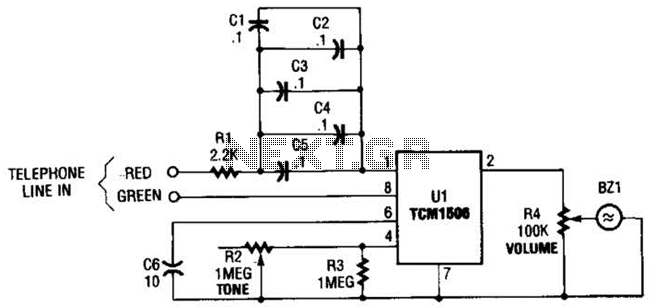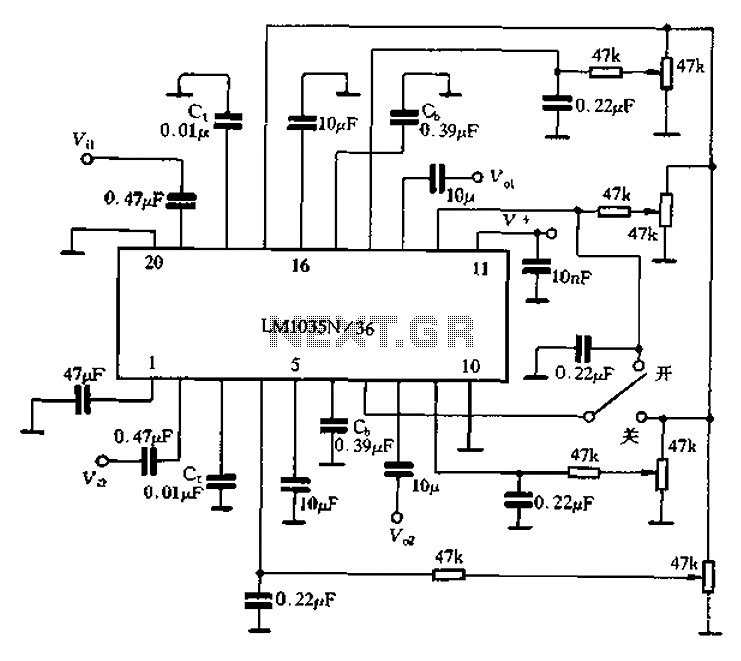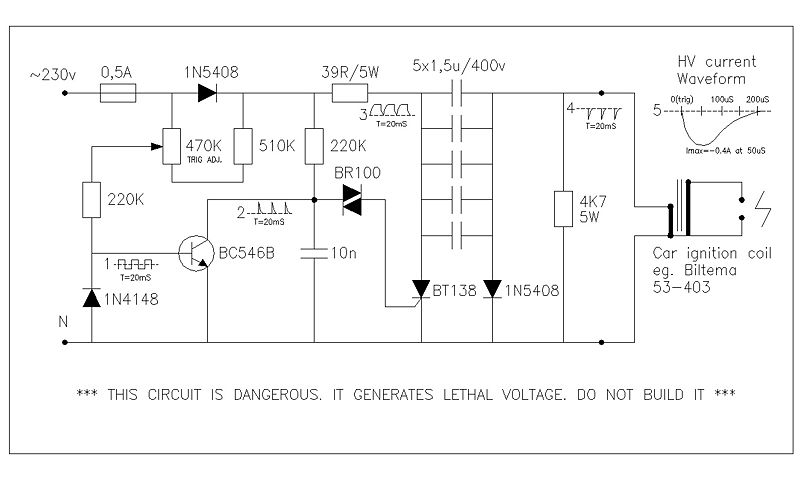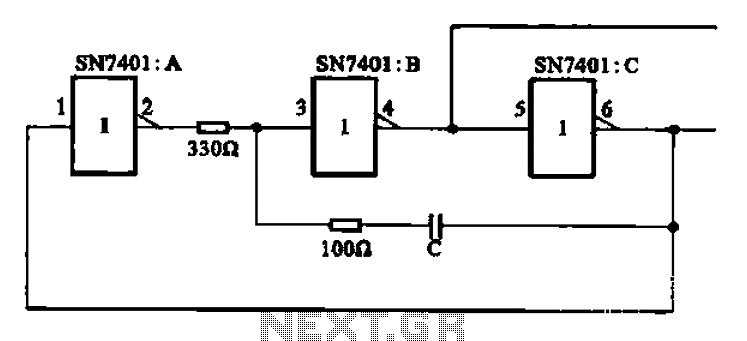
Telephone Ring Converter Circuit

The circuit utilizes the TCM1506 ring detector/driver integrated circuit, which is a monolithic IC designed to replace mechanical bells in telephones. It is powered and activated by the telephone line's ringing signal, which ranges from 40 to 150 V rms at a frequency of 15 to 68 Hz, eliminating the need for an external power source. Capacitors C1 through C5 are arranged in parallel to create a 0.5 µF capacitor that conducts the AC ringing voltage to pin 1 of the TCM1506 while blocking any DC components. These capacitors can be substituted with a single capacitor rated between 0.47 µF and 0.5 µF, provided it has a minimum rating of 400 V DC.
Resistor R1 is connected in series with the capacitor network to dissipate power from any high-voltage transients that may appear across the line. The attenuated AC voltage reaching pin 1 of U1 powers the chip. Capacitor C6 is included to prevent bell tapping, which is the unwanted ringing of the bell when a phone on the same line is used to dial an outgoing call. This capacitor blocks short dial pulses from activating the ring detector while allowing the longer ring signal to trigger it. Potentiometer R2 adjusts the tone of the ring signal, varying it from below 100 Hz to over 15 kHz. Potentiometer R4 serves as the volume control; setting this potentiometer to its lowest resistance mutes the piezo element (BZ1). When a ringing signal is detected on the phone line, it powers U1, which generates a tone with a frequency determined by R2 and an amplitude set by R4, producing sound through BZ1.
The TCM1506 ring detector/driver circuit is designed to efficiently manage ringing signals in telephone systems. It operates by detecting the AC ringing voltage, which is critical for activating the internal circuitry of the IC. The capacitor network serves a dual purpose: it allows the AC signal to pass while blocking any DC offset, ensuring that only the ringing signal is processed. The careful selection of capacitor values and ratings is crucial to prevent damage from high-voltage transients, which can occur during line disturbances.
The inclusion of C6 is significant in preventing false triggering of the detector during dialing, a common issue in shared line applications. This capacitor's role is to filter out the short pulses generated when dialing, allowing only the sustained ringing signal to activate the detection circuitry. The use of potentiometers for tone and volume control provides flexibility in the circuit's operation, allowing end-users to customize their ringing experience.
The piezo element (BZ1) is the final output device, converting the electrical signals generated by the TCM1506 into audible sound. The interaction between the various components ensures that the circuit not only performs reliably but also meets the user’s preferences for sound characteristics. This design exemplifies the integration of modern electronic components in traditional applications, enhancing functionality while maintaining simplicity. The circuit is based on the TCM1506 ring detector/driver integrated circuit. It is a monolithic IC specifically designed to replace-the telephone`s mechanical bell. The chip is powered and activated by the telephone-line ring, which can vary from 40 to 150 V rms at a frequency of from 15 to 68 Hz. No other source of power is required. Again, referring to the figure shown, CI through C5 are placed in parallel to form a 0.5- capacitor that conducts the ac ring voltage to pin 1 of the TCM1506, but blocks any dc component.
Of course, those capacitors can be replaced by a single 0.47- to 0.5- capacitor provided that it has at least a 400-WVdc rating. Resistor Rl is in series with the capacitor network and is used to dissipate power from any high-voltage transient that might appear across the line. The diluted ac voltage that reaches pin 1 on Ul powers the chip. Capacitor C6 is used to prevent bell tapping. That is an annoying ringing of the bell that occurs when a phone on the same line is used to dial an outgoing call.
The capacitor prevents the short dial pulses from triggering the ring detector, but still allows the much longer ring signal to activate it. Potentiometer R2 is used to vary the tone of the ring signal from below 100 Hz to over 15 kHz. Potentiometer R4 is the volume control; adjusting that potentiometer to its lowest resistance will mute the piezo element (BZ1).
When a ring signal is present on the phone-line, it powers Ul. The IC then generates a tone (with a frequency that is determined by R2 and an amplitude set by R4) that is reproduced by BZ1.
Resistor R1 is connected in series with the capacitor network to dissipate power from any high-voltage transients that may appear across the line. The attenuated AC voltage reaching pin 1 of U1 powers the chip. Capacitor C6 is included to prevent bell tapping, which is the unwanted ringing of the bell when a phone on the same line is used to dial an outgoing call. This capacitor blocks short dial pulses from activating the ring detector while allowing the longer ring signal to trigger it. Potentiometer R2 adjusts the tone of the ring signal, varying it from below 100 Hz to over 15 kHz. Potentiometer R4 serves as the volume control; setting this potentiometer to its lowest resistance mutes the piezo element (BZ1). When a ringing signal is detected on the phone line, it powers U1, which generates a tone with a frequency determined by R2 and an amplitude set by R4, producing sound through BZ1.
The TCM1506 ring detector/driver circuit is designed to efficiently manage ringing signals in telephone systems. It operates by detecting the AC ringing voltage, which is critical for activating the internal circuitry of the IC. The capacitor network serves a dual purpose: it allows the AC signal to pass while blocking any DC offset, ensuring that only the ringing signal is processed. The careful selection of capacitor values and ratings is crucial to prevent damage from high-voltage transients, which can occur during line disturbances.
The inclusion of C6 is significant in preventing false triggering of the detector during dialing, a common issue in shared line applications. This capacitor's role is to filter out the short pulses generated when dialing, allowing only the sustained ringing signal to activate the detection circuitry. The use of potentiometers for tone and volume control provides flexibility in the circuit's operation, allowing end-users to customize their ringing experience.
The piezo element (BZ1) is the final output device, converting the electrical signals generated by the TCM1506 into audible sound. The interaction between the various components ensures that the circuit not only performs reliably but also meets the user’s preferences for sound characteristics. This design exemplifies the integration of modern electronic components in traditional applications, enhancing functionality while maintaining simplicity. The circuit is based on the TCM1506 ring detector/driver integrated circuit. It is a monolithic IC specifically designed to replace-the telephone`s mechanical bell. The chip is powered and activated by the telephone-line ring, which can vary from 40 to 150 V rms at a frequency of from 15 to 68 Hz. No other source of power is required. Again, referring to the figure shown, CI through C5 are placed in parallel to form a 0.5- capacitor that conducts the ac ring voltage to pin 1 of the TCM1506, but blocks any dc component.
Of course, those capacitors can be replaced by a single 0.47- to 0.5- capacitor provided that it has at least a 400-WVdc rating. Resistor Rl is in series with the capacitor network and is used to dissipate power from any high-voltage transient that might appear across the line. The diluted ac voltage that reaches pin 1 on Ul powers the chip. Capacitor C6 is used to prevent bell tapping. That is an annoying ringing of the bell that occurs when a phone on the same line is used to dial an outgoing call.
The capacitor prevents the short dial pulses from triggering the ring detector, but still allows the much longer ring signal to activate it. Potentiometer R2 is used to vary the tone of the ring signal from below 100 Hz to over 15 kHz. Potentiometer R4 is the volume control; adjusting that potentiometer to its lowest resistance will mute the piezo element (BZ1).
When a ring signal is present on the phone-line, it powers Ul. The IC then generates a tone (with a frequency that is determined by R2 and an amplitude set by R4) that is reproduced by BZ1.





